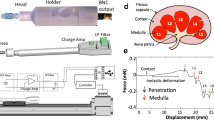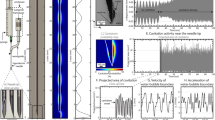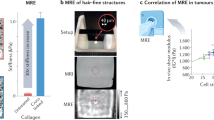Abstract
Needles for percutaneous biopsies of tumour tissue can be guided by ultrasound or computed tomography. However, despite best imaging practices and operator experience, high rates of inadequate tissue sampling, especially for small lesions, are common. Here, we introduce a needle-shaped ultrathin piezoelectric microsystem that can be injected or mounted directly onto conventional biopsy needles and used to distinguish abnormal tissue during the capture of biopsy samples, through quantitative real-time measurements of variations in tissue modulus. Using well-characterized synthetic soft materials, explanted tissues and animal models, we establish experimentally and theoretically the fundamental operating principles of the microsystem, as well as key considerations in materials choices and device designs. Through systematic tests on human livers with cancerous lesions, we demonstrate that the piezoelectric microsystem provides quantitative agreement with magnetic resonance elastography, the clinical gold standard for the measurement of tissue modulus. The piezoelectric microsystem provides a foundation for the design of tools for the rapid, modulus-based characterization of tissues.
This is a preview of subscription content, access via your institution
Access options
Access Nature and 54 other Nature Portfolio journals
Get Nature+, our best-value online-access subscription
$29.99 / 30 days
cancel any time
Subscribe to this journal
Receive 12 digital issues and online access to articles
$99.00 per year
only $8.25 per issue
Buy this article
- Purchase on Springer Link
- Instant access to full article PDF
Prices may be subject to local taxes which are calculated during checkout





Similar content being viewed by others
References
Maharaj, B. et al. Sampling variability and its influence on the diagnostic yield of percutaneous needle biopsy of the liver. Lancet 327, 523–525 (1986).
Saggese, M., Dua, D., Simmons, E., Lemech, C. & Arkenau, H.-T. Research biopsies in the context of early phase oncology studies: clinical and ethical considerations. Oncol. Rev. 7, e5 (2013).
Regev, A. et al. Sampling error and intraobserver variation in liver biopsy in patients with chronic HCV infection. Am. J. Gastroenterol. 97, 2614–2618 (2002).
Shyamala, K., Girish, H. C. & Murgod, S. Risk of tumor cell seeding through biopsy and aspiration cytology. J. Int. Soc. Prev. Community Dent. 4, 5–11 (2014).
National Cancer Institute N CI-MATCH Trial (Molecular Analysis for Therapy Choice) (2017); https://www.cancer.gov/about-cancer/treatment/clinical-trials/nci-supported/nci-match
Rago, T., Santini, F., Scutari, M., Pinchera, A. & Vitti, P. Elastography: new developments in ultrasound for predicting malignancy in thyroid nodules. J. Clin. Endocrinol. Metab. 92, 2917–2922 (2007).
Geraghty, P. R. et al. CT-guided transthoracic needle aspiration biopsy of pulmonary nodules: needle size and pneumothorax rate. Radiology 229, 475–481 (2003).
Picarelli, A. et al. Production of antiendomysial antibodies after in-vitro gliadin challenge of small intestine biopsy samples from patients with coeliac disease. Lancet 348, 1065–1067 (1996).
Discher, D. E., Janmey, P. & Wang, Y. L. Tissue cells feel and respond to the stiffness of their substrate. Science 310, 1139–1143 (2005).
Abramowitch, S. D., Feola, A., Jallah, Z. & Moalli, P. A. Tissue mechanics, animal models, and pelvic organ prolapse: a review. Eur. J. Obstet. Gynecol. Reprod. Biol. 144, S146–S158 (2009).
Fung, Y. C. Biomechanics: Mechanical Properties of Living Tissues (Springer, New York, 2013).
Ziol, M. et al. Noninvasive assessment of liver fibrosis by measurement of stiffness in patients with chronic hepatitis C. Hepatology 41, 48–54 (2005).
O’Rourke, M. F. & Safar, M. E. Relationship between aortic stiffening and microvascular disease in brain and kidney: cause and logic of therapy. Hypertension 46, 200–204 (2005).
Li, M. et al. Modeling lung deformation: a combined deformable image registration method with spatially varying Young’s modulus estimates. Med. Phys. 40, 081902 (2013).
Miller, K. & Chinzei, K. Mechanical properties of brain tissue in tension. J. Biomech. 35, 483–490 (2002).
Wickramaratne, D. et al. Fine needle elastography (FNE) device for biomechanically determining local variations of tissue mechanical properties. J. Biomech. 48, 81–88 (2015).
Yeh, W.-C. et al. Elastic modulus measurements of human liver and correlation with pathology. Ultrasound Med. Biol. 28, 467–474 (2002).
Diridollou, S. et al. In vivo model of the mechanical properties of the human skin under suction. Skin Res. Technol. 6, 214–221 (2000).
Samani, A., Zubovits, J. & Plewes, D. Elastic moduli of normal and pathological human breast tissues: an inversion-technique-based investigation of 169 samples. Phys. Med. Biol. 52, 1565–1576 (2007).
Rho, J. Y., Roy, M. E., Tsui, T. Y. & Pharr, G. M. Elastic properties of microstructural components of human bone tissue as measured by nanoindentation. J. Biomed. Mater. Res. A 45, 48–54 (1999).
Nightingale, K., Soo, M. S., Nightingale, R. & Trahey, G. Acoustic radiation force impulse imaging: in vivo demonstration of clinical feasibility. Ultrasound Med. Biol. 28, 227–235 (2002).
Castera, L., Vilgrain, V. & Angulo, P. Noninvasive evaluation of NAFLD. Nat. Rev. Gastroenterol. Hepatol. 10, 666–675 (2013).
Leung, V. Y. et al. Quantitative elastography of liver fibrosis and spleen stiffness in chronic hepatitis B carriers: comparison of shear-wave elastography and transient elastography with liver biopsy correlation. Radiology 269, 910–918 (2013).
Muthupillai, R. et al. Magnetic resonance elastography by direct visualization of propagating acoustic strain waves. Science 269, 1854–1857 (1995).
Sinkus, R. et al. High-resolution tensor MR elastography for breast tumour detection. Phys. Med. Biol. 45, 1649 (2000).
Goss, B. C., McGee, K. P., Ehman, E. C., Manduca, A. & Ehman, R. L. Magnetic resonance elastography of the lung: technical feasibility. Magn. Reson. Med. 56, 1060–1066 (2006).
Agid, R. et al. CT-guided biopsy with cutting-edge needle for the diagnosis of malignant lymphoma: experience of 267 biopsies. Clin. Radiol. 58, 143–147 (2003).
Mirnezami, R., Nicholson, J. & Darzi, A. Preparing for precision medicine. N. Engl. J. Med. 366, 489–491 (2012).
Dagdeviren, C. et al. Conformal piezoelectric systems for clinical and experimental characterization of soft tissue biomechanics. Nat. Mater. 14, 728–736 (2015).
Carlson, A., Bowen, A. M., Huang, Y., Nuzzo, R. G. & Rogers, J. A. Transfer printing techniques for materials assembly and micro/nanodevice fabrication. Adv. Mater. 24, 5284–5318 (2012).
Jeong, J.-W. et al. Wireless optofluidic systems for programmable in vivo pharmacology and optogenetics. Cell 162, 662–674 (2015).
Koh, A. et al. Ultrathin injectable sensors of temperature, thermal conductivity, and heat capacity for cardiac ablation monitoring. Adv. Healthc. Mater. 5, 373–381 (2016).
Wang, Z., Volinsky, A. A. & Gallant, N. D. Nanoindentation study of polydimethylsiloxane elastic modulus using Berkovich and flat punch tips. J. Appl. Polym. Sci. 132, 41384 (2015).
Mauck, R. L. et al. Functional tissue engineering of articular cartilage through dynamic loading of chondrocyte-seeded agarose gels. J. Biomech. Eng. 122, 252–260 (2000).
Normand, V., Lootens, D. L., Amici, E., Plucknett, K. P. & Aymard, P. New insight into agarose gel mechanical properties. Biomacromolecules 1, 730–738 (2000).
Travessa, D., Ferrante, M. & den Ouden, G. Diffusion bonding of aluminium oxide to stainless steel using stress relief interlayers. Mater. Sci. Eng. A 337, 287–296 (2002).
Purton, D. & Payne, J. Comparison of carbon fiber and stainless steel root canal posts. Quintessence Int. 27, 93–97 (1996).
Fang, H. et al. Capacitively coupled arrays of multiplexed flexible silicon transistors for long-term cardiac electrophysiology. Nat. Biomed. Eng. 1, 0038 (2017).
Rotsch, C., Braet, F., Wisse, E. & Radmacher, M. AFM imaging and elasticity measurements on living rat liver macrophages. Cell Biol. Int. 21, 685–696 (1997).
Adler, A., Cowley, E. A., Bates, J. H. T. & Eidelman, D. H. Airway-parenchymal interdependence after airway contraction in rat lung explants. J. Appl. Physiol. 85, 231–237 (1998).
Wyss, H. M. et al. Biophysical properties of normal and diseased renal glomeruli. Am. J. Physiol. Cell Physiol. 300, C397–C405 (2011).
Bruix, J. & Sherman, M. Management of hepatocellular carcinoma: an update. Hepatology 53, 1020–1022 (2011).
Liaw, Y.-F. & Chu, C.-M. Hepatitis B virus infection. Lancet 373, 582–592 (2009).
Bravo, A. A., Sheth, S. G. & Chopra, S. Liver biopsy. N. Engl. J. Med. 344, 495–500 (2001).
Ahrar, K. in Percutaneous Image-Guided Biopsy 19–32 (Springer, New York, 2014).
Mariappan, Y. K., Glaser, K. J. & Ehman, R. L. Magnetic resonance elastography: a review. Clin. Anat. 23, 497–511 (2010).
Manduca, A. et al. Magnetic resonance elastography: non-invasive mapping of tissue elasticity. Med. Image Anal. 5, 237–254 (2001).
Stylianopoulos, T. et al. Causes, consequences, and remedies for growth-induced solid stress in murine and human tumors. Proc. Natl Acad. Sci. USA 109, 15101–15108 (2012).
Do, K., O’Sullivan Coyne, G. & Chen, A. P. An overview of the NCI precision medicine trials—NCI MATCH and MPACT. Chin. Clin. Oncol. 4, 31 (2015).
Acknowledgements
This work was supported by the Center for Bio-Integrated Electronics. R.O. acknowledges National Institutes of Health grants R01HL137193, R01EB24403, R21EB021148 and R03CA172738, and Mayo Clinic. R.S. acknowledges support from the Engineering and Physical Sciences Research Council (grant number EP/L016028/1) and China Scholarship Council. L.T. acknowledges support from a Beckman Institute postdoctoral fellowship at the University of Illinois Urbana-Champaign. Y.H. acknowledges support from the National Science Foundation (grant numbers 1400169, 1534120 and 1635443) and National Institutes of Health (grant number R01EB019337). The authors acknowledge N. Pallace (Media Support Services at Mayo Clinic) for expert photography during the experiments.
Author information
Authors and Affiliations
Contributions
X.Y., H.W., X.N., Y.H., R.O. and J.A.R. designed the experiment and wrote the manuscript. X.Y., H.W., X.N., R.S., M.S., H.A., Y.Y., A.K., C.M.L., A.C.S., P.T. and R.O. performed the experiments and analysed the experimental data. H.W. led the structural designs and mechanics modelling, with assistance from J.Y. L.T. and M.P. contributed to the analysis of the experimental results.
Corresponding authors
Ethics declarations
Competing interests
The authors declare no competing interests.
Additional information
Publisher’s note: Springer Nature remains neutral with regard to jurisdictional claims in published maps and institutional affiliations.
Supplementary information
Supplementary Information
Supplementary notes and figures.
Rights and permissions
About this article
Cite this article
Yu, X., Wang, H., Ning, X. et al. Needle-shaped ultrathin piezoelectric microsystem for guided tissue targeting via mechanical sensing. Nat Biomed Eng 2, 165–172 (2018). https://doi.org/10.1038/s41551-018-0201-6
Received:
Accepted:
Published:
Issue Date:
DOI: https://doi.org/10.1038/s41551-018-0201-6
This article is cited by
-
Designing transparent piezoelectric metasurfaces for adaptive optics
Nature Communications (2024)
-
A Survey of Needle Steering Approaches in Minimally Invasive Surgery
Annals of Biomedical Engineering (2024)
-
Label-free multimodal electro-thermo-mechanical (ETM) phenotyping as a novel biomarker to differentiate between normal, benign, and cancerous breast biopsy tissues
Journal of Biological Engineering (2023)
-
Thin, soft, wearable system for continuous wireless monitoring of artery blood pressure
Nature Communications (2023)
-
A Hybrid Dynamic Model for a Rotary Piezoelectric Motor Without Sliding Friction
Journal of Vibration Engineering & Technologies (2023)



